Publisher’s NOTE: Over the past eight-plus months, we have continued to read many stories about the problems with water all over this nation. Some of what is posted below, includes a degree of repetition, however it is worth expanding on this horrible situation – as it DOES affect the health of each and everyone of us. There is an old saying that, “you are what you eat.” Now it becomes important to NOT become what you drink. ~ J.B.
 Every state in the nation has breached the Safe Drinking Water Act combining in 80,000 safety violations affecting 77 million people’s drinking water.
Every state in the nation has breached the Safe Drinking Water Act combining in 80,000 safety violations affecting 77 million people’s drinking water.
A report by the Natural Resources Defense Council (NRDC) found that 15 percent of those offenses were health-based contamination, including lead, copper, arsenic or cancer-causing poisons.
These pollutants can lead to liver and kidney damage, cancer and birth defects. Lead exposure is especially detrimental to children with possible learning disabilities and damage to the central nervous system.
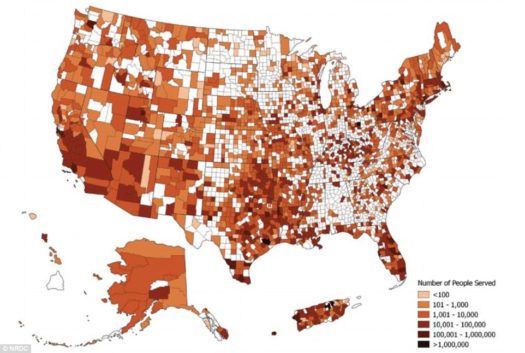
A report by the Natural Resources Defense Council found 15 percent or nearly 30 million of Americans had tap water with health-based violations in 2015. The contamination included lead, copper, arsenic or cancer-causing poisons in the water. Pictured: Map showing counties with health-based water contamination
The most at-risk for having a contaminated water supply system were those in small rural communities of around 500 people. This made up 70 percent of the reported offenses.
Erik Olson, the health program director at NRDC and a report co-author, said: ‘America is facing a nationwide drinking water crisis that goes well beyond lead contamination.
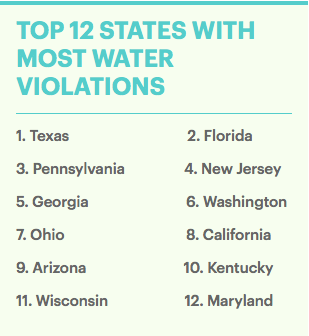 ‘The problem is two-fold: there’s no cop on the beat enforcing our drinking water laws, and we’re living on borrowed time with our ancient, deteriorating water infrastructure.
‘The problem is two-fold: there’s no cop on the beat enforcing our drinking water laws, and we’re living on borrowed time with our ancient, deteriorating water infrastructure.
‘We take it for granted that when we turn on our kitchen tap, the water will be safe and healthy, but we have a long way to go before that is reality across our country.’
Although Flint, Michigan, has been the focal point for critically unsafe water, the problem is more widespread, the report claims.
The crisis in Flint has been ongoing since 2014 when the city switched its supply to a local river instead of relying on Detroit’s water in effort to save money.
Soon after the change, residents began to complain about the smell and it was revealed that lead had contaminated the water supply.
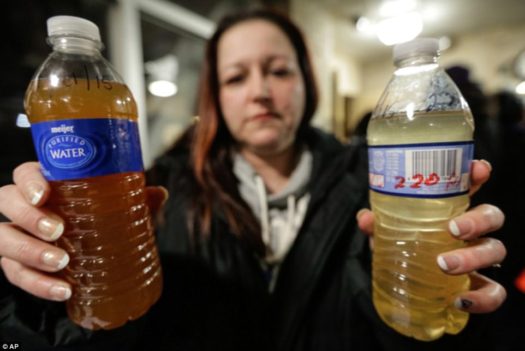 Some 8,000 children are believed to have been exposed to lead poisoning since the scandal, which has drawn national attention and led to criminal charges against six state employees.
Some 8,000 children are believed to have been exposed to lead poisoning since the scandal, which has drawn national attention and led to criminal charges against six state employees.
Lead poisoning poses a large threat to infants, children and pregnant mothers. Women who drink contaminated lead water can harm the fetus by reduced growth and premature birth.
Adults can be affected by cardiovascular effects, increased blood pressure, decreased kidney function and reproductive problems, according to the EPA. WATER IS TOO EXPENSIVE FOR 14 MILLION AMERICANS
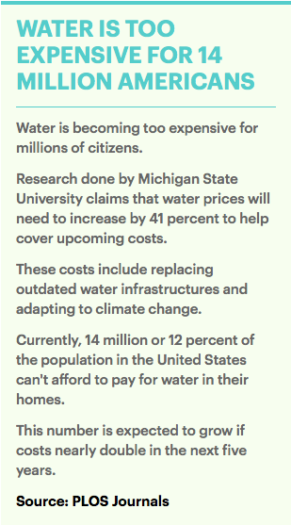 The people of Flint reported skin rashes and hair loss from drinking the tainted water.
The people of Flint reported skin rashes and hair loss from drinking the tainted water.
They were so concerned about the health repercussions, several stopped showering and relied on wipes instead.
Human skin does not absorb lead in water.
In 2015, 18 million people’s water supply had lead violations, according to the NRDC.
In addition to lead begin found in water, other pollutants were found across the nation.
In 2016, a Harvard University study found that more than six million people were drinking water with deadly toxins.
Drinking this water could lead to cancer, obesity, high cholesterol and may be linked to reproductive impacts such as miscarriages and birth defects, the findings claim.
In the recent report, there were often failures to report the serious contamination levels and 90 percent of the violations were subject to no formal action.
The NRDC also reports there is anywhere from six to 10 million water service lines made of lead and need to be replaced.
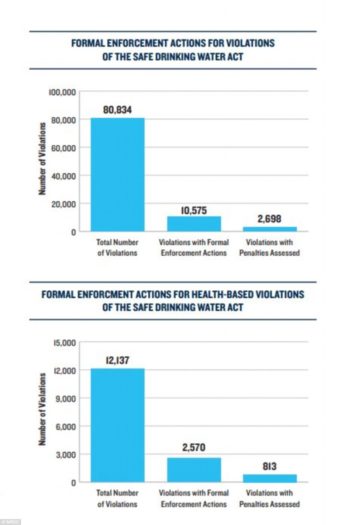 In 2015, 18 million people’s water supply had lead violations, according to the NRDC. However a large part of the violations had no formal enforcement actions (pictured)
In 2015, 18 million people’s water supply had lead violations, according to the NRDC. However a large part of the violations had no formal enforcement actions (pictured)
RELATED: Deadly toxic chemicals found in drinking water for at least 6 MILLION Americans
The report comes on the heels of President Trump’s proposed cuts to the Environmental Protection Agency’s budget for next year, including $600 million cut to water-related programs.

Phoenix, Arizona, has the highest amount of chromium-6 in its water supply, with almost 400 times the amount that the California scientists set as a health goal
Money also was being taken from the EPA’s enforcement budget, which would mean these violations would be harder to correct in the future.
Consuming contaminated or unsafe water is dangerous for humans but the dirty water also poses a threat to crops and livestock.
Vegetables and fruit exposed to contaminated water pose a risk to people who eat them.
They could contract a food-borne illness. Some of the bacteria spread through water within the United States include E. coli, Salmonella and hepatitis A virus, according to the CDC.
TIMELINE OF FLINT’S CONTAMINATED WATER SUPPLY
Authorities in the financially struggling city of Flint, Michigan, switched its water source from Detroit’s system to the Flint River to save money in April 2014.
The river water was more corrosive than the Detroit system’s and caused more lead to leach from Flint’s aging pipes.
Lead can be toxic and children are especially vulnerable.
Some 8,000 children are believed to have been exposed to lead poisoning since April 2014. And there has been an uptick in cases of Legionnaire’s disease.
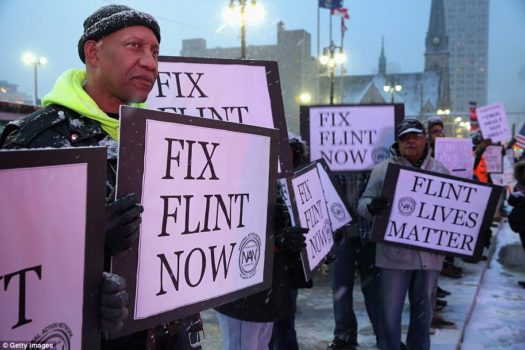
Demonstrators demand action from the GOP presidential candidates about the water crisis in Flint before the GOP presidential debate on March 3, 2016 in Detroit, Michigan
The social costs stemming from the scandal amount to $395 million, according to a recent analysis by a professor at the Columbia University Mailman School of Public Health.
RELATED: So, is it 6 Million, 30 Million Americans or 218 Million Americans, who have been affected? Brockovich: Water, Water – Everywhere, but…
The crisis has prompted lawsuits by parents in Flint, which has a population of about 100,000, who say their children have shown dangerously high levels of lead in their blood.
In July six state employees in Michigan were criminally charged in connection with the case.
Some critics have called for high-ranking state officials, including Governor Rick Snyder, to be charged. Snyder said he believes he’s done nothing criminally wrong.
Here is a timeline of the events:
APRIL 2014: In an effort to save money, Flint began drawing its water from the Flint River instead of relying on water from Detroit.
The move was considered temporary while the city waited to connect to a new regional water system. Residents immediately complained about the smell, taste and appearance of the water. They also raised health concerns, reporting rashes, hair loss and other problems.

To save money, Flint began drawing its water from the Flint River (pictured) instead of Detroit’s in 2014. Residents immediately complained about the smell and taste of the water
SUMMER 2014: Three boil-water advisories were issued in 22 days after positive tests for coliform bacteria.
OCTOBER 2014: A General Motors engine plant stopped using Flint water, saying it rusted parts.
JANUARY 2015: Flint sought an evaluation of its efforts to improve the water amid concerns that it contained potentially harmful levels of a disinfection byproduct.
Detroit offered to reconnect Flint to its water system. Flint insisted its water was safe.
JAN. 28 2015: Flint residents snapped up 200 cases of bottled water in 30 minutes in a giveaway program. More giveaways followed in ensuing months.
FEB. 3 2015: State officials pledged $2 million for Flint’s troubled water system.
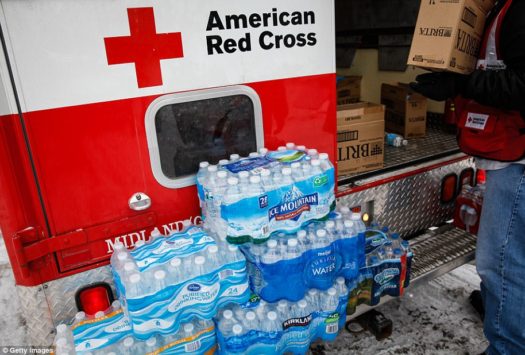
Flint residents snapped up 200 cases of bottled water in 30 minutes in a giveaway program. More giveaways followed in ensuing months
FEBRUARY 2015: A 40-member advisory committee was formed to address concerns over Flint’s water. Mayor Dayne Walling said the committee would ensure the community was involved in the issue.
MARCH 19 2015: Flint promised to spend $2.24 million on immediate improvements to its water supply.
MARCH 27 2015: Flint officials said the quality of its water had improved and that testing found the water met all state and federal standards for safety.
SEPT. 24 2015: A group of doctors led by Dr. Mona Hanna-Attisha of Hurley Medical Center urged Flint to stop using the Flint River for water after finding high levels of lead in the blood of children. State regulators insisted the water was safe.
SEPT. 29 2015: Gov. Rick Snyder pledged to take action in response to the lead levels. It was the first acknowledgment by the state that lead was a problem.
OCT. 2 2015: Snyder announced that the state would spend $1 million to buy water filters and test water in Flint public schools.
OCT. 8 2015: Snyder called for Flint to go back to using water from Detroit’s system again.
OCT. 15 2015: The Michigan Legislature and Snyder approved nearly $9.4 million in aid to Flint, including $6 million to help switch its drinking water back to Detroit. The legislation also included money for water filters, inspections and lab testing.
NOV. 3 2015: Voters elected newcomer Karen Weaver over incumbent Mayor Dayne Walling amid fallout over the drinking water.
DEC. 29 2015: Snyder accepted the resignation of Department of Environmental Quality Director Dan Wyant and apologized for what occurred in Flint.

Governor Rick Snyder (pictured) hit back at critics who said he should be charged. At a hearing in 2016, Snyder said he believes he has not done anything criminally wrong
JAN. 5 2016: Snyder declared a state of emergency in Flint, the same day federal officials confirmed that they were investigating.
JAN. 12 2016: Snyder activated the Michigan National Guard to help distribute bottled water and filters in Flint and asked the federal government for help.
JAN. 13 2016: Michigan health officials reported an increase in Legionnaires’ disease cases during periods over the past two years in the county that includes Flint.
JAN. 14 2016: Snyder asked the Obama administration for major disaster declaration and more federal aid.
JAN. 16 2016: President Barack Obama signed emergency declaration and ordered federal aid for Flint, authorizing the Federal Emergency Management Agency and the Department of Homeland Security to coordinate relief efforts.
APRIL 2016: Governor Rick Snyder hit back at critics who said he should be charged. Snyder said he believes he’s done nothing criminally wrong.
JULY 2016: Six state employees in Michigan criminally charged in connection with the case.
RELATED: Water, Water Everywhere – the Complete File
Written and compiled by Cheyenne Roundtree for The Daily Mail ~ May 9, 2017
 FAIR USE NOTICE: This site contains copyrighted material the use of which has not always been specifically authorized by the copyright owner. We are making such material available in our efforts to advance understanding of environmental, political, human rights, economic, democracy, scientific, and social justice issues, etc. We believe this constitutes a ‘fair use’ of any such copyrighted material as provided for in section 107 of the US Copyright Law. In accordance with Title 17 U. S. C. Section 107, the material on this site is distributed without profit to those who have expressed a prior interest in receiving the included information for research and educational purposes. For more information go to: http://www.law.cornell.edu/uscode/17/107.shtml“
FAIR USE NOTICE: This site contains copyrighted material the use of which has not always been specifically authorized by the copyright owner. We are making such material available in our efforts to advance understanding of environmental, political, human rights, economic, democracy, scientific, and social justice issues, etc. We believe this constitutes a ‘fair use’ of any such copyrighted material as provided for in section 107 of the US Copyright Law. In accordance with Title 17 U. S. C. Section 107, the material on this site is distributed without profit to those who have expressed a prior interest in receiving the included information for research and educational purposes. For more information go to: http://www.law.cornell.edu/uscode/17/107.shtml“
